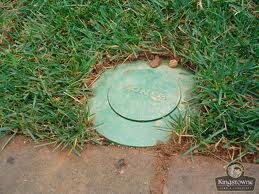When I talk to a potential customer while doing a Drainage System estimate, I take a lot of things into consideration. First I have the Customer show me where water is standing or where it is going that it shouldn't. This is part of defining the specific problem area. Sometimes the Water Problem Area is larger and more involved than the customer realizes. Once the Water Problem Area is clearly defined, the next step is to determine how the water is getting to the problem area. Many times there is more than one Water Source to the Water Problem area. A big mistake in Drainage System Design is to stop once the most obvious Water Source is found. A Drainage System Designer must be a detective to some degree. For Example: Water running down the hill and onto the back patio might be the most obvious water source. Sub-surface water or a neighbor's new gutter downspout could also be contributing. Most of the time water gets into the problem area from more than one source.
- This is a good place for a French Drain
Next you must decide where to take the water. This is determining an Exit Point for the Drainage System. If possible you want your exit point to be down hill from the problem area. If it is up hill in all directions from the problem area, then the only solution is a Sump Pump.
Once an exit Point is determined, you must ask yourself if there is any way to install two exit points. Usually this can only work when an exit point can work on both ends of a Drainage System. The benefit of two Exit Points in a Drainage System is it greatly increases the water capacity for the Drainage System. It can move much more water faster during a heavy rain than a system with just one Exit Point. Most Drainage Systems can only utilize one Exit Point. In 21 years of Drainage System Installation, I would say 10% of our Drainage Systems have two Exit Points.
- Popup Emitter to release water from a French Drain in Yukon
Next we have to decide what type of drain to install in the problem area. If it is a small area with one water source, Usually a Surface Drain is best. If the water problem area is large with one or several water sources, a French Drain is usually installed.
If you have several problem drainage areas you must use larger Drain Pipe if you want to connect them together to one exit point. Large French Drains should have their own exit point without attaching other Surface Drains or Gutters to them. It is very common to connect too many drains or gutters into a Drainage System. A hard rain can overwhelm the Drainage Systems Water Flow Capacity. When that happens, water backs up and the problem area floods.
- French Drain connected into Drainage System
I just shake my head when I see 3 French Drains and 5 gutters connected into one exit drain pipe. I see this type of design all the time. Why spend money for a Drainage System that won't work? Lots of Cheap Builders and Fly-By-Night Drainage Companies cut corners on Drainage Systems and French Drains on new home construction.
For a French Drain or a Surface Drain or any type of Drainage System, If in doubt, use a larger Drain Pipe. Four Inch Drain Pipe is the most common. Six inch Drain Pipe is always better. If you are going to connect a French Drain and Surface Drain together, use 6 inch Drain Pipe.




No comments:
Post a Comment